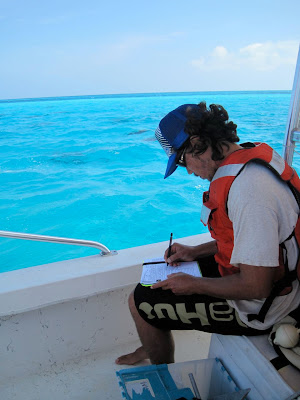 |
| Nihoa Finch, Dave Boynton photography |
 |
| Nihoa Millerbird, photo by Dave Boynton |
Perhaps we could help these two bird species by bringing some to Midway; then they would live on both Nihoa and Midway -- two islands, instead of just one. If a disaster hits one island, the birds would be able to survive on the other island.
But before we can think about doing such an expensive translocation, we have to know how healthy Midway’s environment is. And it turns out there is a disease on the Atoll that could hurt the two Nihoa birds.
Have you ever caught a cold or had the flu? You can feel pretty awful. Both colds and flu are caused by small germs you can’t see called viruses.
Avian, or bird, “pox” (rhymes with box) is a virus that attacks birds. Since avian pox is sort of related to chicken pox, if you’ve ever had the itchy, oozy sores of chicken pox, you’ll know how painful avian pox must be for birds. In fact, birds can die from the pox!
Two kinds of avian pox were accidentally brought to Hawai`i: the fowl pox and canary pox. The fowl pox only affects chickens, but the canary pox causes serious problems for Hawai`i's native birds. Because the birds have never been exposed to the pox before, they haven’t evolved resistance to the disease, and many have become extinct. Happily, there are still `Amakihi in some of Hawai`i's forests, but here’s a picture of an `Amakihi with a bad case of avian pox on its foot.
 |
| 'Amakihi with avian pox, photo by Dr. Dennis LaPointe |
Bird pox is carried from one bird to another by touch. If a bird preens a diseased bird with pox-infected blisters and then pokes another bird, breaking its skin, the bird pox virus will be transferred. A mosquito can transmit the virus if the insect gets pox on its mouth parts and then bites a healthy bird.
Does Midway have avian pox? What kind? Is it a kind that could hurt the Nihoa Finch and Millerbird, if they’re brought to Midway? Dr. Carter Atkinson and Dr. Dennis LaPointe from the U.S. Geological Survey’s Pacific Island Ecosystems Research Center in Volcano on the Big Island of Hawai`i are on Midway to survey bird pox. They will find out what kind of avian pox is in the atoll’s birds and mosquitoes. Because canary birds were brought to Midway as song birds over 100 years ago, Carter and Dennis think the dangerous canary pox is here. Take a look at the 2 pictures below showing Dennis with a mosquito trap, and a canary.



























